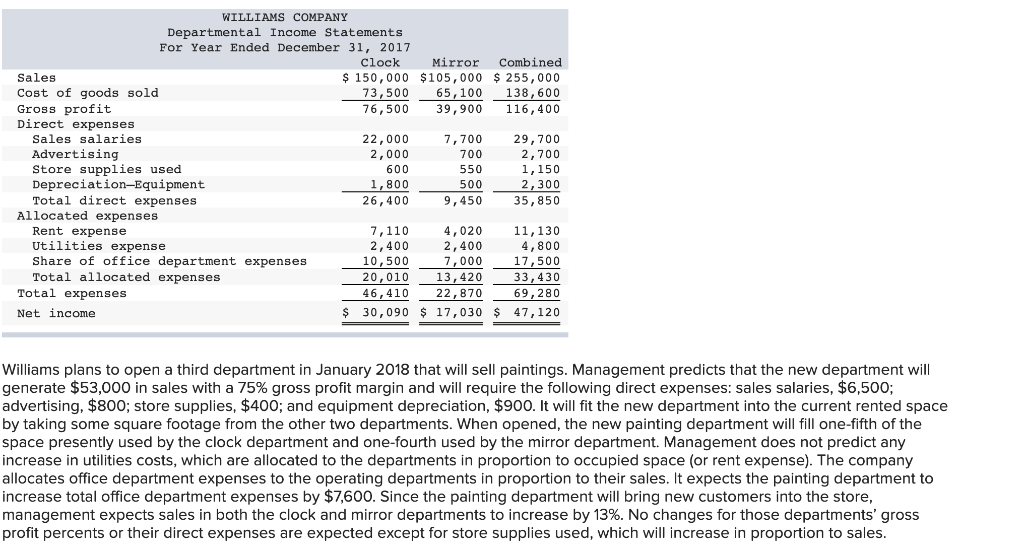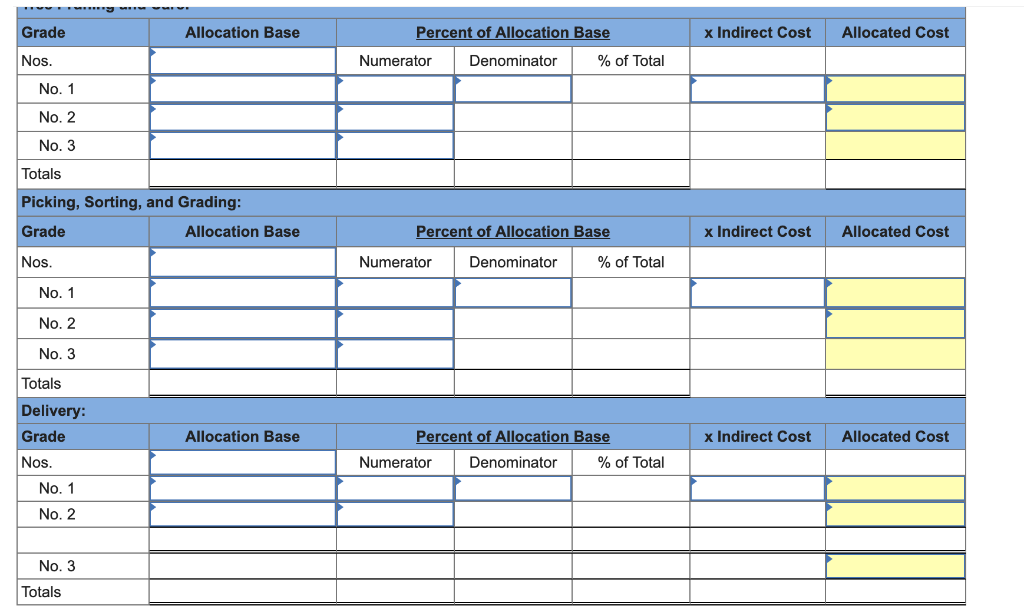

Q.2


WILLIAMS COMPANY Departmental Income Statements For Year Ended December 31, 2017 Clock Mirror Combined Sales $ 150,000 $105,000 $ 255,000 Cost of goods sold 73,500 65,100 138,600 Gross profit 76,500 39,900 116,400 Direct expenses Sales salaries 22,000 7,700 29,700 Advertising 2,000 700 2,700 Store supplies used 600 550 1,150 Depreciation Equipment 1,800 500 2,300 Total direct expenses 26,400 35,850 Allocated expenses Rent expense 7,110 020 11,130 Utilities expense 2,400 4,800 Share of office department expenses 10,500 7,000 17,500 Total allocated expenses 20,010 13, 420 33, 430 Total expenses 46,410 22,870 69,280 Net income $ 30,090 $ 17,030 $ 47,120 450 2,400 Williams plans to open a third department in January 2018 that will sell paintings. Management predicts that the new department will generate $53,000 in sales with a 75% gross profit margin and will require the following direct expenses: sales salaries, $6,500; advertising, $800; store supplies, $400; and equipment depreciation, $900. It will fit the new department into the current rented space by taking some square footage from the other two departments. When opened, the new painting department will fill one-fifth of the space presently used by the clock department and one-fourth used by the mirror department. Management does not predict any increase in utilities costs, which are allocated to the departments in proportion to occupied space (or rent expense). The company allocates office department expenses to the operating departments in proportion to their sales. It expects the painting department to increase total office department expenses by $7,600. Since the painting department will bring new customers into the store, management expects sales in both the clock and mirror departments to increase by 13%. No changes for those departments' gross profit percents or their direct expenses are expected except for store supplies used, which will increase in proportion to sales. Required: Prepare departmental income statements that show the company's predicted results of operations for calendar-year 2018 for the three operating (selling) departments and their combined totals. (Do not round intermediate calculations. Round your final answers to nearest whole dollar amount.) WILLIAMS COMPANY Forecasted Departmental Income Statements For Year Ended December 31, 2018 Clock Mirror Paintings Combined Direct expenses Total direct expenses Allocated expenses Total allocated expenses Total expenses Required information Problem 24-5AC Allocation of joint costs LO C3 (The following information applies to the questions displayed below. Georgia Orchards produced a good crop of peaches this year. After preparing the following income statement, the company is concerned about the net loss on its No. 3 peaches. GEORGIA ORCHARDS Income Statement For Year Ended December 31, 2017 No. 1 No. 2 No. 3 Combined Sales (by grade) No. 1: 247,500 Ibs. @ $1.80/lb $445,500 No. 2: 247,500 Ibs. @ $1.40/lb $346,500 No. 3: 792,000 Ibs. @ $0.25/lb $ 198,000 Total sales $990,000 Costs Tree pruning and care @ $0.30/Ib 74,250 74,250 237,600 386, 100 Picking, sorting, and grading @ $0.20/Ib 49,500 49,500 158, 400 257,400 Delivery costs 15,000 15,000 37,600 67,600 Total costs 138,750 138,750 433,600 711,100 Net income (loss) $306, 750 $207,750 $ (235, 600) $278,900 In preparing this statement, the company allocated joint costs among the grades on a physical basis as an equal amount per pound. The company's delivery cost records show that $30,000 of the $67,600 relates to crating the No. 1 and No. 2 peaches and hauling them to the buyer. The remaining $37,600 of delivery costs is for crating the No. 3 peaches and hauling them to the cannery. x Indirect Cost Allocated Cost Percent of Allocation Base Numerator Denominator % of Total Grade Allocation Base Nos. No. 1 No. 2 No. 3 Totals Picking, Sorting, and Grading: Grade Allocation Base x Indirect Cost Allocated Cost Percent of Allocation Base Numerator Denominator 1 % of Total Nos. No. 1 No. 2 No. 3 Totals Delivery: Grade Allocation Base x Indirect Cost Allocated Cost Percent of Allocation Base Numerator Denominator % of Total Nos. No. 1 No. 2 No. 3 Totals










